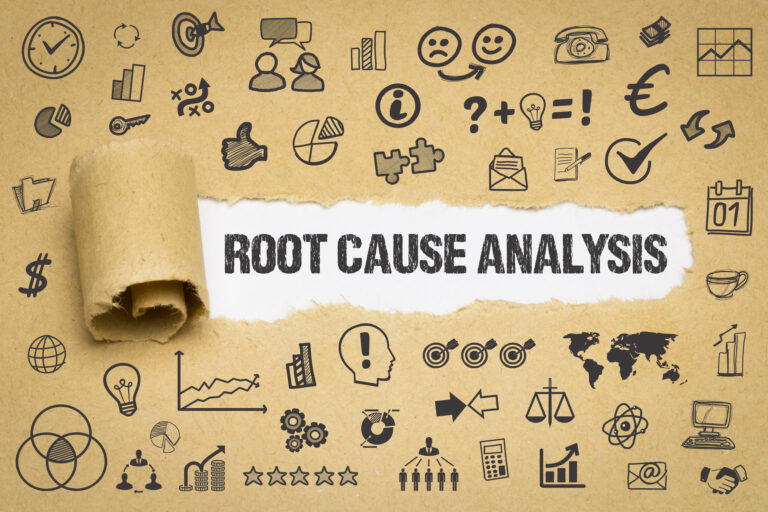Understanding the underlying factors that contribute to workplace accidents that can help organizations implement targeted corrective measures, improve safety protocols, and create a safer work environment. In this blog, we will explore the importance of identifying the root cause analysis in quality, safety, work-related accidents and provide exclusive insights into various methods and techniques that can be employed to uncover these underlying causes.
Why is Root Cause Analysis Important in Quality Improvement?
Most medical errors do not occur due to the actions of one individual. Most medical errors are caused by a system failure. And for this reason, that’s why we do root cause analysis because we’re looking at the system. If there was a medical error, chances are it wasn’t one person’s bad decision-making.
It was a system or a culture that permitted the error to take place and that’s crucial because organizations don’t want to blame people. Quality improvements can’t be made unless the problems are identified. Therefore, it’s so important for a healthcare system to allow the reporting of problems and to conduct root cause analysis to monitor outcomes. The fear of punishment or the fear of legal consequences is a big reason why people might not report any errors that they made.
So you have to remove the barriers to reporting. Punishment should be avoided.
Organizations must focus on the systems. Barriers to reporting errors have to be removed so that the adverse events and the near misses are identified. And then lastly, interdisciplinary groups, including pharmacists, a big high-yield should be involved in quality improvement.
Why is it Important to Identify the Root Cause of Workplace Accidents?
Identifying the root cause helps prevent future accidents by addressing underlying issues. It allows organizations to implement targeted corrective measures and improve safety protocols, ultimately creating a safer work environment. Methods such as the 5 Whys technique, fault tree analysis, and incident investigation interviews can help uncover the root cause.
These methods involve systematically questioning the sequence of events leading to the accident to determine the underlying factors. Employees can provide valuable insights and first-hand knowledge. Conducting interviews or surveys, encouraging anonymous reporting, and creating a culture of open communication can help involve employees in the process of identifying root causes.
What Role Does Data Analysis Play in Identifying the Root Cause of Maintaining Workplace Safety?
Data analysis is crucial in identifying trends, patterns, and commonalities across accidents. Here are the methods followed-
- Analyzing incident reports, near misses, and other relevant data can provide valuable information for determining the root cause.
- Understanding the role of human error helps identify systemic improvements that can be made. Assessing organizational factors involves examining safety policies, procedures, and practices.
- It also involves evaluating the effectiveness of safety training, supervision, and leadership. Identifying any systemic issues helps address them at their core.
- The best tool you can use while conducting root cause analysis is Integrated management system. IMS helps in identifying errors quickly with accurate data by providing detailed analysis over operations, sales performance and more.
- Identifying the root cause of work-related accidents is a proactive approach to maintaining workplace safety.
- By utilizing methods such as the 5 Whys technique, data analysis, and involving employees and experts, organizations can delve beyond the immediate causes and address the systemic issues that contribute to accidents.
- By implementing effective corrective measures based on these root causes, organizations can create a culture of safety, reduce the risk of accidents, and protect the well-being of their employees.
- Prioritizing the identification and resolution of root causes is an essential step in creating a safer and healthier work environment.
What is the Role of Root Cause Analysis in Risk Management?
In the world of finance, organizations lacking effective problem-solving skills and root cause analysis techniques often struggle to address recurring financial issues and mitigate risks effectively. They may treat symptoms rather than underlying causes, fail to identify systemic financial risks or struggle to implement lasting solutions to financial problems.
This can result in persistent financial inefficiencies, repeated risk events and missed opportunities for process improvement. At the individual level, finance professionals may find it challenging to apply structured problem-solving methodologies to complex financial issues, struggle with identifying the true root causes of financial risks, or face difficulties in developing and implementing effective corrective actions. This can lead to superficial problem-solving and inadequate risk mitigation strategies.
This specialized training course comes to the rescue by providing comprehensive knowledge and practical skills in financial risk analysis, root cause identification, and problem-solving techniques. It equips participants with exclusive methodologies to dig deep into financial issues, uncover underlying causes and develop effective solutions. By taking this course, individuals will gain expertise in various root cause analysis tools such as fishbone diagrams, 5-Y analysis, and fault tree analysis applied to financial contexts.
Firms and individuals learn to apply structured problem-solving frameworks, conduct thorough financial risk assessments, and develop action plans that address the core of financial issues. The impact on organizations can be transformative. With professionals skilled in financial risk and root cause analysis, companies can expect more effective resolution of financial problems, improved risk mitigation strategies, and enhanced ability to prevent the recurrence of financial issues.
This leads to increased operational efficiency, reduced financial losses, and a culture of continuous improvement in financial processes. At the personal level, participants will become valuable problem solvers within their organizations. Firms are able to lead financial troubleshooting initiatives, provide insightful analysis of complex financial risks, and drive meaningful improvements in financial processes.
Why Root Cause Analysis is a Game Changer?
If you’re dealing with the same problem over and over then root cause analysis is the tool you need. Root Cause Analysis (RCA) is a like a detective work for your business. Instead of just fixing the surface issue, RCA dives deep to uncover the core reason behind the problem. Think of it as finding that one loose thread in a sweater that unravels the whole thing. RCA becomes a game changer because it prevents recurrence. Once you know the root cause, you can implement changes to make sure the problem does’nt come back. RCA also improves processes. Often, RCA often reveals inefficiencies that you can fix streamline your operations. In industries like healthcare and manufacturing, understanding the root cause of errors that can prevent accidents and save lives. Therefore, Root cause analysis promotes a culture of continuous improvement. By learning from mistakes your team can grow stronger and smarter.
Conclusion
Root cause analysis seeks to identify causative factors that lead to adverse and sentinel events. It refers to a deficiency that, if corrected or avoided, would have eliminated the adverse event to begin with. Strategic planning and management can lead to career advancement opportunities in financial risk management, process improvement and strategic safety management. Don’t let recurring hazards and unresolved risks hinder your organization’s financial health. Empower yourself and your team with the skills to excel in financial risk analysis and problem-solving.



